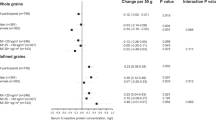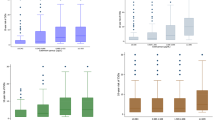Abstract
Background/Objectives:
N-3 polyunsaturated fatty acids (PUFAs) have been associated with reduced inflammation. We tested the hypothesis that high serum concentrations of the n-3 PUFAs are associated with lower serum C-reactive protein (CRP) concentrations in healthy middle-aged Finnish men. We also examined whether exposure to mercury, an environmental contaminant in fish, which is also a major source of long-chain n-3 PUFA, was associated with CRP.
Subjects/Methods:
Data from the prospective, population-based Kuopio Ischaemic Heart Disease Risk Factor Study were analyzed cross-sectionally to determine the associations between serum n-3 PUFAs, hair mercury and serum CRP in 1395 healthy men, aged 42–60 years. Linear regression analyses were performed to analyze the associations.
Results:
In the multivariate models, the mean serum CRP in quartiles of serum total n-3 PUFA concentration was 1.23, 1.27, 1.18 and 1.08 mg/l, P for trend=0.01. Statistically significant inverse associations were also observed with the total serum long-chain n-3 PUFA concentration and with the individual long-chain n-3 PUFAs docosapentaenoic acid and docosahexaenoic acid, but not with eicosapentaenoic acid or with the intermediate-chain n-3 PUFA alpha-linolenic acid. Hair methylmercury content was not associated with serum CRP levels and it did not modify the associations between serum n-3 PUFAs and CRP either.
Conclusions:
Serum n-3 PUFAs and especially the long-chain n-3 PUFA concentration, a marker of fish or fish oil consumption, were inversely associated with serum CRP in men. Exposure to mercury was not associated with serum CRP.
This is a preview of subscription content, access via your institution
Access options
Subscribe to this journal
Receive 12 print issues and online access
$259.00 per year
only $21.58 per issue
Buy this article
- Purchase on Springer Link
- Instant access to full article PDF
Prices may be subject to local taxes which are calculated during checkout
Similar content being viewed by others
References
Albert CM, Ma J, Rifai N, Stampfer MJ, Ridker PM (2002). Prospective study of C-reactive protein, homocysteine, and plasma lipid levels as predictors of sudden cardiac death. Circulation 105, 2595–2599.
Anderson BM, Ma DWL (2009). Are all n-3 polyunsaturated fatty acids created equal? Lipids Health Dis 8, 33.
Basu A, Devaraj S, Jialal I (2006). Dietary factors that promote or retard inflammation. Arterioscler Thromb Vasc Biol 26, 995–1001.
Bouwens M, van de Rest O, Dellschaft N, Grootte Bromhaar M, de Groot LC, Geleijnse JM et al. (2009). Fish-oil supplementation induces antiinflammatory gene expression profiles in human blood mononuclear cells. Am J Clin Nutr 90, 415–424.
Burdge GC (2006). Metabolism of α-linolenic acid in humans. Prostaglandins Leukot Essent Fatty Acids 75, 161–168.
De Caterina R, Libby P (1996). Control of endothelial leukocyte adhesion molecules by fatty acids. Lipids 31, S57–S63.
De Caterina R, Spiecker M, Solaini G, Basta G, Bosetti F, Libby P, Liao J (1999). The inhibition of endothelial activation by unsaturated fatty acids. Lipids 34, S191–S194.
Farzaneh-Far R, Harris WS, Garg S, Na B, Whooley MA (2009). Inverse association of erythrocyte n-3 fatty acid levels with inflammatory biomarkers in patients with stable coronary artery disease: The Heart and Soul Study. Atherosclerosis 205, 538–543.
Ferrucci L, Cherubini A, Bandinelli S, Bartali B, Corsi A, Lauretani F et al. (2006). Relationship of plasma polyunsaturated fatty acids to circulating inflammatory markers. J Clin Endocr Metab 91, 439–446.
Gabay C, Kushner I (1999). Acute-phase proteins and other systemic responses to inflammation. N Engl J Med 340, 448–454.
Geelen A, Brouwer IA, Schouten EG, Kluft C, Katan MB, Zock PL (2004). Intake of n-3 fatty acids from fish does not lower serum concentrations of C-reactive protein in healthy subjects. Eur J Clin Nutr 58, 1440–1442.
Geleijnse JM, de Goede J, Brouwer IA (2010). Alpha-linolenic acid: is it essential to cardiovascular health? Curr Atheroscler Rep 12, 359–367.
Harris WS (2005). Alpha-linolenic acid: a gift from the land? Circulation 111, 2872–2874.
He K, Liu K, Daviglus ML, Jenny NS, Mayer-Davis E, Jiang R et al. (2009). Associations of dietary long-chain n-3 polyunsaturated fatty acids and fish with biomarkers of inflammation and endothelial activation (from the Multi-Ethnic Study of Atherosclerosis [MESA]). Am J Cardiol 103, 1238–1243.
Hunter D (1998). Biochemical indicators of dietary intake. In: Willett W (ed). Nutritional Epidemiology. Oxford University Press: New York, NY. pp 174.
Kalogeropoulos N, Panagiotakos DB, Pitsavos C, Chrysohoou C, Rousinou G, Toutouza M et al. (2010). Unsaturated fatty acids are inversely associated and n-6/n-3 ratios are positively related to inflammation and coagulation markers in plasma of apparently healthy adults. Clin Chim Acta 411, 584–591.
Kaur G, Cameron-Smith D, Garg M, Sinclair AJ (2011). Docosapentaenoic acid (22:5n-3): A review of its biological effects. Prog Lipid Res 50, 28–34.
Klein-Platat C, Drai J, Oujaa M, Schlienger JL, Simon C (2005). Plasma fatty acid composition is associated with the metabolic syndrome and low-grade inflammation in overweight adolescents. Am J Clin Nutr 82, 1178–1184.
Laaksonen DE, Lakka TA, Lakka HM, Nyyssönen K, Rissanen T, Niskanen LK et al. (2002). Serum fatty acid composition predicts development of impaired fasting glycaemia and diabetes in middle-aged men. Diabetic Med 19, 456–464.
Lakka TA, Venäläinen JM, Rauramaa R, Salonen R, Tuomilehto J, Salonen JT (1994). Relation of leisure-time physical activity and cardiorespiratory fitness to the risk of acute myocardial infarction in men. N Engl J Med 330, 1549–1554.
Lopez-Garcia E, Schulze MB, Manson JE, Meigs JB, Albert CM, Rifai N et al. (2004). Consumption of (n-3) fatty acids is related to plasma biomarkers of inflammation and endothelial activation in women. J Nutr 134, 1806–1811.
Madsen T, Christensen JH, Blom M, Schmidt EB (2003). The effect of dietary n-3 fatty acids on serum concentrations of C-reactive protein: a dose–response study. Brit J Nutr 89, 517–522.
Mozaffarian D, Rimm EB (2006). Fish intake, contaminants, and human health, evaluating the risks and the benefits. JAMA 296, 1885–1899.
Nikkari T, Luukkainen P, Pietinen P, Puska P (1995). Fatty acid composition of serum lipid fractions in relation to gender and quality of dietary fat. Ann Med 27, 491–498.
Pepys M, Hirschfield G (2003). C-reactive protein: a critical update. J Clin Invest 111, 1805–1812.
Pischon T, Hankinson SE, Hotamisligil GS, Rifai N, Willet WC, Rimm EB (2003). Habitual dietary intake of n-3 and n-6 fatty acids in relation to inflammatory markers among US men and women. Circulation 108, 155–160.
Poudel-Tandukar K, Nanri A, Matsushita Y, Sasaki S, Ohta M, Sato M et al. (2009). Dietary intakes of α-linolenic and linoleic acids are inversely associated with serum C-reactive protein levels among Japanese men. Nutr Res 29, 363–370.
Ross R (1999). Atherosclerosis-an inflammatory disease. N Engl J Med 340, 115–126.
Salonen JT (1988). Is there a continuing need for longitudinal epidemiologic research? The Kuopio Ischaemic Heart Disease Risk Factor Study. Ann Clin Res 20, 46–50.
Salonen JT, Nyyssonen K, Korpela H, Tuomilehto J, Seppanen R, Salonen R (1992). High stored iron levels are associated with excess risk of myocardial infarction in eastern Finnish men. Circulation 86, 803–811.
Salonen JT, Seppanen K, Nyyssonen K, Korpela H, Kauhanen J, Kantola M et al. (1995). Intake of mercury from fish, lipid peroxidation, and the risk of myocardial infarction and coronary, cardiovascular, and any death in eastern Finnish men. Circulation 91, 645–655.
Simopoulos AP (2002). Omega-3 fatty acids in inflammation and autoimmune diseases. J Am Coll Nutr 21, 495–505.
Skulas-Ray AC, Kris-Etherton PM, Harris WS, Vanden Heuvel JP, Wagner PR, West SG (2011). Dose-response effects of omega-3 fatty acids on triglycerides, inflammation, and endothelial function in healthy persons with moderate hypertriglyceridemia. Am J Clin Nutr 93, 243–252.
Virtanen JK, Mursu J, Voutilainen S, Tuomainen T-P (2009). Serum long-chain n-3 polyunsaturated fatty acids and risk of hospital diagnosis of atrial fibrillation in men. Circulation 120, 2315–2321.
Virtanen JK, Voutilainen S, Rissanen TH, Mursu J, Tuomainen TP, Korhonen MJ et al. (2005). Mercury, fish oils, and risk of acute coronary events and cardiovascular disease, coronary heart disease, and all-cause mortality in men in eastern Finland. Arterioscler Thromb Vasc Biol 25, 228–233.
Voutilainen S, Rissanen TH, Virtanen J, Lakka TA, Salonen JT (2001). Low dietary folate intake is associated with an excess incidence of acute coronary events: the Kuopio Ischaemic Heart Disease Risk Factor Study. Circulation 103, 2674–2680.
Wang C, Harris WS, Chung M, Lichtenstein AH, Balk EM, Kupelnick B et al. (2006). n3 Fatty acids from fish or fish-oil supplements, but not α-linolenic acid, benefit cardiovascular disease outcomes in primary-and secondary-prevention studies: a systematic review. Am J Clin Nutr 84, 5–17.
Author information
Authors and Affiliations
Corresponding author
Ethics declarations
Competing interests
The authors declare no conflict of interest.
Rights and permissions
About this article
Cite this article
Reinders, I., Virtanen, J., Brouwer, I. et al. Association of serum n-3 polyunsaturated fatty acids with C-reactive protein in men. Eur J Clin Nutr 66, 736–741 (2012). https://doi.org/10.1038/ejcn.2011.195
Received:
Revised:
Accepted:
Published:
Issue Date:
DOI: https://doi.org/10.1038/ejcn.2011.195
Keywords
This article is cited by
-
Circulating fatty acid profiles are associated with protein energy wasting in maintenance hemodialysis patients: a cross-sectional study
Scientific Reports (2021)
-
The associations of serum n-6 polyunsaturated fatty acids with serum C-reactive protein in men: the Kuopio Ischaemic Heart Disease Risk Factor Study
European Journal of Clinical Nutrition (2018)
-
Genome-wide interaction of genotype by erythrocyte n-3 fatty acids contributes to phenotypic variance of diabetes-related traits
BMC Genomics (2014)
-
Association of red blood cell n-3 polyunsaturated fatty acids with plasma inflammatory biomarkers among the Quebec Cree population
European Journal of Clinical Nutrition (2014)
-
Polyunsaturated Fatty Acids and Their Relation with Bone and Muscle Health in Adults
Current Osteoporosis Reports (2013)



